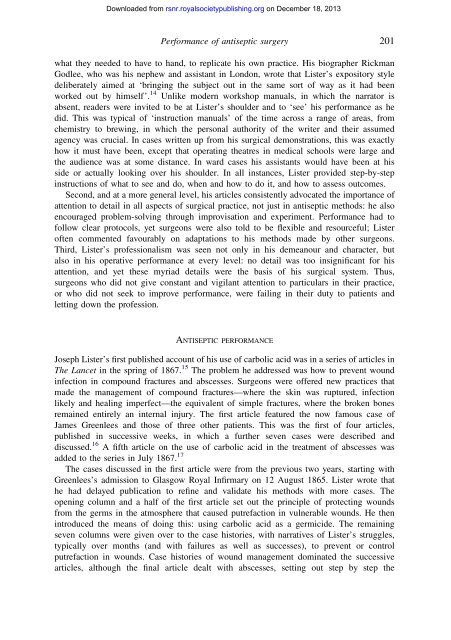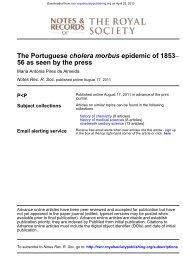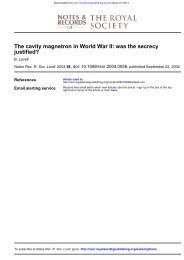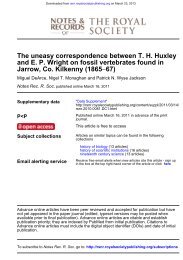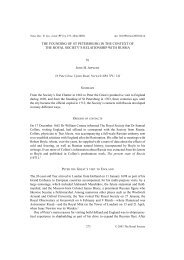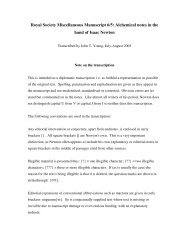JOSEPH LISTER AND THE PERFORMANCE OF ANTISEPTIC ...
JOSEPH LISTER AND THE PERFORMANCE OF ANTISEPTIC ...
JOSEPH LISTER AND THE PERFORMANCE OF ANTISEPTIC ...
You also want an ePaper? Increase the reach of your titles
YUMPU automatically turns print PDFs into web optimized ePapers that Google loves.
Downloaded from rsnr.royalsocietypublishing.org on December 18, 2013<br />
Performance of antiseptic surgery 201<br />
what they needed to have to hand, to replicate his own practice. His biographer Rickman<br />
Godlee, who was his nephew and assistant in London, wrote that Lister’s expository style<br />
deliberately aimed at ‘bringing the subject out in the same sort of way as it had been<br />
worked out by himself’. 14 Unlike modern workshop manuals, in which the narrator is<br />
absent, readers were invited to be at Lister’s shoulder and to ‘see’ his performance as he<br />
did. This was typical of ‘instruction manuals’ of the time across a range of areas, from<br />
chemistry to brewing, in which the personal authority of the writer and their assumed<br />
agency was crucial. In cases written up from his surgical demonstrations, this was exactly<br />
how it must have been, except that operating theatres in medical schools were large and<br />
the audience was at some distance. In ward cases his assistants would have been at his<br />
side or actually looking over his shoulder. In all instances, Lister provided step-by-step<br />
instructions of what to see and do, when and how to do it, and how to assess outcomes.<br />
Second, and at a more general level, his articles consistently advocated the importance of<br />
attention to detail in all aspects of surgical practice, not just in antiseptic methods: he also<br />
encouraged problem-solving through improvisation and experiment. Performance had to<br />
follow clear protocols, yet surgeons were also told to be flexible and resourceful; Lister<br />
often commented favourably on adaptations to his methods made by other surgeons.<br />
Third, Lister’s professionalism was seen not only in his demeanour and character, but<br />
also in his operative performance at every level: no detail was too insignificant for his<br />
attention, and yet these myriad details were the basis of his surgical system. Thus,<br />
surgeons who did not give constant and vigilant attention to particulars in their practice,<br />
or who did not seek to improve performance, were failing in their duty to patients and<br />
letting down the profession.<br />
<strong>ANTISEPTIC</strong> <strong>PERFORMANCE</strong><br />
Joseph Lister’s first published account of his use of carbolic acid was in a series of articles in<br />
The Lancet in the spring of 1867. 15 The problem he addressed was how to prevent wound<br />
infection in compound fractures and abscesses. Surgeons were offered new practices that<br />
made the management of compound fractures—where the skin was ruptured, infection<br />
likely and healing imperfect—the equivalent of simple fractures, where the broken bones<br />
remained entirely an internal injury. The first article featured the now famous case of<br />
James Greenlees and those of three other patients. This was the first of four articles,<br />
published in successive weeks, in which a further seven cases were described and<br />
discussed. 16 A fifth article on the use of carbolic acid in the treatment of abscesses was<br />
added to the series in July 1867. 17<br />
The cases discussed in the first article were from the previous two years, starting with<br />
Greenlees’s admission to Glasgow Royal Infirmary on 12 August 1865. Lister wrote that<br />
he had delayed publication to refine and validate his methods with more cases. The<br />
opening column and a half of the first article set out the principle of protecting wounds<br />
from the germs in the atmosphere that caused putrefaction in vulnerable wounds. He then<br />
introduced the means of doing this: using carbolic acid as a germicide. The remaining<br />
seven columns were given over to the case histories, with narratives of Lister’s struggles,<br />
typically over months (and with failures as well as successes), to prevent or control<br />
putrefaction in wounds. Case histories of wound management dominated the successive<br />
articles, although the final article dealt with abscesses, setting out step by step the


